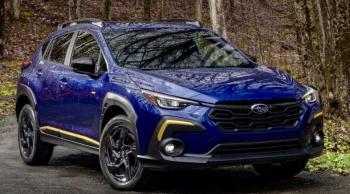Subaru Crosstrek Sport
 With both rear seatbacks folded down, the re-designed 2024 Crosstrek offers up to 54.7 cubic feet of useful space plus a tailgate opening that’s 41 inches across. The Sport model gets raised roof rails. (Think kayaks, paddleboards, skis.) This color is Sapphire Blue Pearl; note the hot-gold highlights and the Sport trim’s 18-inch Dark Gray Alloy wheels.
With both rear seatbacks folded down, the re-designed 2024 Crosstrek offers up to 54.7 cubic feet of useful space plus a tailgate opening that’s 41 inches across. The Sport model gets raised roof rails. (Think kayaks, paddleboards, skis.) This color is Sapphire Blue Pearl; note the hot-gold highlights and the Sport trim’s 18-inch Dark Gray Alloy wheels.
 This is the available 11.6-inch Subaru StarLink infotainment system. Wireless Apple CarPlay and Android Auto are also available, while the latest generation of Subaru’s comprehensive EyeSight Driver Assist Technology is standard on all Crosstrek trim levels.
This is the available 11.6-inch Subaru StarLink infotainment system. Wireless Apple CarPlay and Android Auto are also available, while the latest generation of Subaru’s comprehensive EyeSight Driver Assist Technology is standard on all Crosstrek trim levels.
 With both rear seatbacks folded down, the re-designed 2024 Crosstrek offers up to 54.7 cubic feet of useful space plus a tailgate opening that’s 41 inches across. The Sport model gets raised roof rails. (Think kayaks, paddleboards, skis.) This color is Sapphire Blue Pearl; note the hot-gold highlights and the Sport trim’s 18-inch Dark Gray Alloy wheels.
With both rear seatbacks folded down, the re-designed 2024 Crosstrek offers up to 54.7 cubic feet of useful space plus a tailgate opening that’s 41 inches across. The Sport model gets raised roof rails. (Think kayaks, paddleboards, skis.) This color is Sapphire Blue Pearl; note the hot-gold highlights and the Sport trim’s 18-inch Dark Gray Alloy wheels.
 This is the available 11.6-inch Subaru StarLink infotainment system. Wireless Apple CarPlay and Android Auto are also available, while the latest generation of Subaru’s comprehensive EyeSight Driver Assist Technology is standard on all Crosstrek trim levels.
This is the available 11.6-inch Subaru StarLink infotainment system. Wireless Apple CarPlay and Android Auto are also available, while the latest generation of Subaru’s comprehensive EyeSight Driver Assist Technology is standard on all Crosstrek trim levels.
In Subaru’s family of five SUVs, the Crosstrek is the best-seller and also the baby—the smallest and least expensive. But it’s no longer a stripped-out loss-leader. Yes, with a starting price of $26,540, it’s still aimed at younger buyers who are just embarking on their earning years, but in comfort, convenience and features—and of course Subaru’s trademark utility and off-roadiness—it gives up very little beyond interior volume to its larger siblings. And it is spacious, at that; bigger on the inside than on the outside, we might say.
The pace of change in Subaru styling is glacial (at least in the old sense, before glaciers began to retreat like wounded animals), so most of us won’t pick out this 2024 model as a newly overhauled third-generation Crosstrek. Not only does it look very like its predecessor, it’s also packing the same powerplants. The base engine is a 2.0-litre Four rated for 152 horsepower, while our uprated Crosstrek Sport comes with a 2.5-litre Four that makes 182 horsepower and 178 pound-feet of torque. Both are traditional Subaru “boxer” motors, and both are connected to Subaru’s well-developed Lineartronic continuously variable (CVT) automatic transmissions with shift paddles that let the driver select from among eight “gears.” A manual gearbox is no longer available in any Crosstrek.
All Subarus are all-wheel-drive all the time, and the Crosstrek is no exception. For an explanation of the company’s trademark Symmetrical AWD and its boxer engines, I refer you back to the Subaru Forester of 9 July.
What sets this Gen-Three Crosstrek apart from its predecessors is its relative refinement. To begin, Subaru has managed to stiffen the chassis by some 10 percent; this may sound like a negative, but a chassis that flexes less allows the suspension, steering and brakes to perform their jobs better. Subaru also says it has tweaked the Crosstrek’s AWD system to respond faster, and the Sport’s X-MODE lets the driver toggle easily between Snow/Dirt and Deep Snow/Mud settings. Hill Descent Control and Incline Start Assist are there too, along with decent ground clearance.
Subaru claims that several aerodynamic improvements enhance the Crosstrek’s performance and stability at speed by reducing lift as well as air trapped in the wheel wells and the rear bumper. However, the most noticeable refinements are in the cabin, which gets more comfortable and supportive front seats, more sound-deadening and a nicer finish. As an “adventure” vehicle, the Crosstrek Sport may not be as fun to drive as, say, a Huracan Sterrato, but it is a lot easier to live with.
Five Crosstrek trim levels are available: Base, Premium, Sport, Limited and, for the boondockers, Wilderness. Suggested retail prices range from a low of $26,540 to a high of $33,290. With but one option—$141 rubber floor mats—our sample Sport has a sticker price of $30,431.
PS—Two weeks ago, covering the Toyota Camry XSE, I promised a look at the Hyundai Tucson. However, the one that arrived was a 2024 model and, since the ‘25s are now at the dealerships and they differ from the ‘24s, I opted to wait until the new one shows up.
Next week: Hyundai Ioniq 6
























